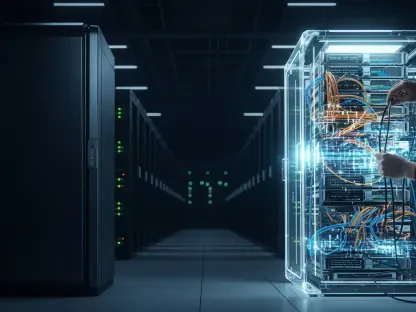In an era where cyber threats are becoming increasingly sophisticated and pervasive, the integration of artificial intelligence into cybersecurity strategies has evolved from a competitive edge to an absolute necessity for organizations across the globe. From insidious phishing schemes and deceptive deepfakes to critical vulnerabilities in cloud infrastructures and generative AI systems, the spectrum of digital risks continues to expand at an alarming rate. As attackers leverage cutting-edge technologies to exploit weaknesses, businesses and institutions are compelled to adopt AI-driven solutions to safeguard their assets and maintain trust in an interconnected world. This exploration delves into the forefront of cybersecurity innovation, spotlighting the transformative trends and pioneering tools that are redefining how threats are detected, mitigated, and prevented. By embracing these advancements, the industry is shifting toward a proactive stance, ensuring that defenses are not just reactive but anticipatory in nature, ready to counter the next wave of cyber challenges with precision and speed.
Transforming Security Operations with AI
Revolutionizing Routine Tasks
The advent of AI in cybersecurity has ushered in a new era of automation, particularly in the realm of routine security operations that once consumed countless hours of human effort. Tools such as Torq HyperSOC™ and Radiant Security SOC Automation are at the forefront, managing repetitive tasks like threat monitoring, alert triage, and initial incident response with remarkable efficiency. This shift significantly reduces the burden on security analysts, allowing them to redirect their focus toward more complex, strategic challenges that require human intuition and expertise. By automating high-volume alert processing, these systems ensure that critical threats are identified and addressed swiftly, minimizing the risk of oversight during peak attack periods. The result is a streamlined workflow where response times are slashed, and the overall resilience of security operations is enhanced, marking a pivotal change in how organizations manage their defensive posture.
Enhancing Analyst Productivity
Beyond simply automating tasks, AI is redefining the role of cybersecurity professionals by amplifying their productivity and decision-making capabilities in high-pressure environments. With platforms leveraging machine learning to filter out noise and prioritize genuine threats, analysts can dedicate their energy to investigating sophisticated attacks and crafting long-term defense strategies. This transformation is vital as the volume of cyber incidents continues to surge, often overwhelming traditional manual processes. AI-driven automation not only accelerates the identification of potential breaches but also provides actionable insights through data correlation, enabling teams to respond with greater precision. Moreover, by reducing alert fatigue—a common issue in Security Operations Centers—AI ensures that human resources are utilized effectively, fostering a more sustainable and focused approach to cybersecurity management. This synergy between technology and human expertise is proving indispensable in maintaining robust defenses.
Anticipating and Preventing Cyber Threats
Predictive Intelligence as a Game-Changer
A significant shift in cybersecurity is the move from reactive measures to predictive strategies, driven by AI’s unparalleled ability to analyze vast datasets and forecast potential attack vectors before they materialize. Platforms like SentinelOne Singularity XDR and Deep Instinct are leading this charge, excelling in real-time detection and prevention of zero-day threats that often evade conventional defenses. By sifting through global threat intelligence and historical patterns, these tools empower organizations to fortify their systems preemptively, addressing vulnerabilities long before exploitation occurs. This predictive capability is a cornerstone of modern cybersecurity, offering a proactive shield against the ever-evolving tactics of cybercriminals. As attack surfaces widen with the proliferation of connected devices and cloud environments, the ability to anticipate threats becomes not just advantageous but critical for safeguarding digital ecosystems.
Building Resilient Defenses
The emphasis on predictive intelligence is complemented by AI’s role in building resilient defenses that adapt to emerging risks over time. Unlike static security measures that rely on predefined rules, AI systems continuously learn from new data, refining their understanding of normal operations and anomalous behavior to better protect against future incursions. This adaptability ensures that organizations are not perpetually playing catch-up with attackers who innovate at a rapid pace. By integrating predictive analytics with automated response mechanisms, these solutions can neutralize threats in their infancy, often before significant damage is inflicted. Furthermore, the insights derived from AI-driven analysis help security architects design more robust policies and protocols tailored to specific organizational needs. This dynamic approach to defense underscores a fundamental evolution in cybersecurity, where anticipation and prevention take precedence over mere reaction, securing a stronger foundation for digital trust.
Evolving Toward Adaptive and Context-Aware Defenses
Smarter Zero Trust Implementations
AI is breathing new life into the Zero Trust security model by making it more intelligent and context-aware, moving beyond rigid, one-size-fits-all access controls to dynamic systems that respond to real-time conditions. These advanced frameworks evaluate factors such as user behavior, device health, and geographic location to make informed decisions about access permissions, ensuring that trust is never assumed but always verified. This continuous validation process significantly reduces the risk of unauthorized access and lateral movement by malicious actors within a network. By embedding AI into Zero Trust architectures, organizations can create a security posture that evolves with the threat landscape, offering a more nuanced and effective barrier against breaches. This trend represents a critical step forward in protecting complex, distributed environments where traditional perimeter-based defenses fall short.
Reducing Insider Threats
Another vital aspect of context-aware defenses is their ability to mitigate insider threats, which remain a persistent challenge for many organizations due to their often subtle and hard-to-detect nature. AI systems analyze patterns of user activity to identify deviations that might indicate malicious intent or compromised credentials, even among trusted employees. By focusing on behavioral anomalies rather than static roles, these tools provide a deeper layer of security that traditional methods cannot match. This approach not only prevents potential data leaks but also helps in distinguishing between genuine mistakes and intentional sabotage, preserving organizational integrity. Additionally, the integration of such adaptive measures into broader security strategies ensures a comprehensive defense that addresses both external and internal risks. As cyber threats become more personalized and sophisticated, leveraging AI to monitor and respond to insider activities is becoming an essential component of a holistic security framework.
Combating AI-Generated Cyber Attacks
Detecting Synthetic Threats
As cybercriminals increasingly exploit AI to craft convincing deepfakes and synthetic phishing content, the development of countermeasures has become a pressing priority for the cybersecurity community. Advanced detection tools employing multi-modal verification techniques are emerging to identify and neutralize these fabricated threats, which often bypass traditional security filters due to their lifelike nature. These solutions analyze various data points—voice, imagery, and text patterns—to distinguish between authentic and artificial content, offering a robust defense against social engineering tactics that prey on human trust. This focus on countering AI-generated attacks highlights the dual-edged nature of the technology, where it serves as both a weapon for adversaries and a shield for defenders. Staying ahead in this cat-and-mouse game requires constant innovation to ensure that detection capabilities keep pace with the evolving sophistication of synthetic threats.
Strengthening Social Engineering Defenses
Beyond detection, AI is also fortifying defenses against the broader spectrum of social engineering attacks that leverage synthetic content to manipulate individuals and infiltrate systems. By integrating behavioral analysis with content verification, security platforms can flag suspicious interactions that deviate from established norms, even if the content appears legitimate at first glance. This layered approach is crucial in an environment where attackers use AI to personalize phishing emails or mimic trusted voices, exploiting psychological vulnerabilities with alarming precision. Furthermore, educating end-users about these risks remains a complementary strategy, but AI-driven tools provide the first line of defense by automating the identification process. As these threats grow in complexity, the ability to rapidly discern and block deceptive content becomes a linchpin of organizational security, ensuring that human error does not become a gateway for catastrophic breaches.
Navigating Challenges in Generative AI Systems
Ensuring Reliability of AI Outputs
The rise of generative AI and large language models has introduced unprecedented capabilities, but also unique vulnerabilities that cybersecurity must address, such as unreliable outputs or hallucinations that could mislead critical decision-making processes. Innovations like RAG-Verification (Retrieval-Augmented Generation) are being developed to enhance the traceability and accuracy of AI-generated content, ensuring that outputs are grounded in verified data sources. This is particularly vital in high-stakes environments where erroneous information could lead to disastrous outcomes, such as misconfigured security protocols or flawed threat assessments. By implementing these safeguards, organizations can maintain trust in AI systems, leveraging their potential while minimizing the risks associated with unchecked outputs. This balance is essential for integrating generative AI into cybersecurity frameworks without compromising operational integrity.
Protecting Against Prompt Injection Attacks
Another pressing concern with generative AI is the risk of prompt injection attacks, where malicious inputs manipulate AI models to produce harmful or unintended results, potentially exposing sensitive data or disrupting systems. Security measures are evolving to detect and block such exploits by scrutinizing input patterns and establishing strict boundaries for AI responses. These protective mechanisms are crucial for preventing attackers from exploiting the inherent openness of language models to bypass security controls. Additionally, ongoing research into robust model training aims to reduce the susceptibility of AI systems to adversarial inputs, fortifying them against manipulation. As generative AI becomes more embedded in cybersecurity operations, addressing these vulnerabilities is not just a technical necessity but a strategic imperative to preserve the reliability and safety of digital infrastructures facing increasingly cunning threats.
Showcasing Leading AI Cybersecurity Solutions
Highlighting Innovative Platforms
The landscape of cybersecurity is being reshaped by a suite of AI-powered tools designed to tackle diverse threats across endpoints, networks, and cloud environments with unmatched precision. Platforms like AccuKnox AI CoPilot stand out for their focus on cloud-native and Kubernetes security, utilizing generative AI for automated policy enforcement and zero-trust principles. Similarly, CrowdStrike Falcon Cloud Security offers real-time detection capabilities, seamlessly integrating across endpoint and cloud systems to provide comprehensive protection. Microsoft Security Copilot enhances incident response through natural language workflows, simplifying complex tasks for security teams. These tools exemplify the breadth of innovation in the field, addressing specific pain points while reinforcing broader defensive strategies. Their adoption signals a maturing market where AI is not just an add-on but a fundamental driver of security resilience.
Catering to Diverse Environments
Complementing these platforms are solutions like Zscaler Cloud Security and Fortinet FortiAI, which cater to the needs of distributed and hybrid environments with AI-driven suites for secure web gateways and threat analysis. Zscaler’s cloud-delivered approach ensures scalability for remote workforces, enforcing zero-trust network access with precision, while Fortinet’s machine learning capabilities provide inline remediation to neutralize threats in real time. Additionally, tools like Deep Instinct focus on deep learning to prevent malware and ransomware, particularly zero-day exploits that traditional defenses often miss. This diversity in offerings reflects the industry’s recognition that no single solution fits all; instead, tailored AI applications are necessary to secure varied digital ecosystems. As organizations navigate increasingly complex infrastructures, these cutting-edge platforms provide the adaptability and strength needed to counter sophisticated cyber threats effectively.
Reflecting on AI’s Impact on Cybersecurity
Looking back, the integration of artificial intelligence into cybersecurity marked a turning point in how digital threats were addressed, shifting the paradigm from reactive fixes to proactive fortifications. The automation of routine tasks in Security Operations Centers alleviated human workloads, while predictive analytics empowered teams to foresee and thwart attacks before they unfolded. Context-aware Zero Trust models and defenses against AI-generated threats, such as deepfakes, demonstrated the technology’s versatility in tackling both internal and external risks. Moreover, innovations to secure generative AI systems underscored the industry’s commitment to balancing opportunity with caution. For the road ahead, organizations should prioritize investing in scalable AI tools, fostering cross-departmental collaboration to integrate these technologies seamlessly, and staying vigilant about emerging vulnerabilities. By building on these past advancements, the cybersecurity community can continue to refine its arsenal, ensuring that digital landscapes remain secure against ever-evolving adversities.









